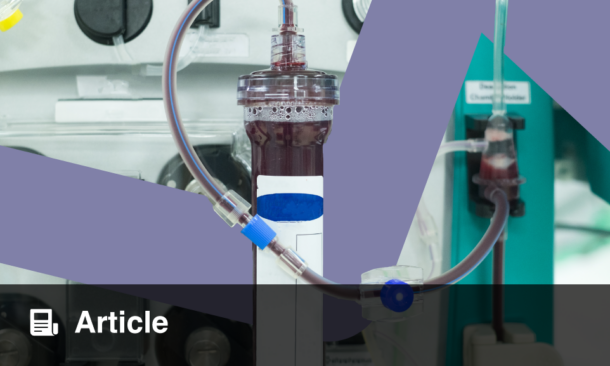Interviewees: Patrice Ambühl,1 Jordi Bover2
1. Institute for Nephrology, Stadtspital Waid and Triemli, Zurich, Switzerland
2. Department of Nephrology, Fundació Puigvert, Barcelona, Spain
Disclosure: Prof Ambühl is a member of advisory boards for Vifor-Fresenius-Renal Pharma and Astra Zeneca. Prof Bover has received advisory, lecture fees, and/or travel funding from Amgen, Abbvie, Sanofi-Genzyme, Shire, Vifor-Fresenius-Renal Pharma, Rubió, and Sanifit.
Acknowledgements: Medical writing assistance was provided by Dr Juliet George, Chester, UK.
Disclaimer: The opinions expressed in this article belong solely to the named interviewees.
Support: Publication of this interview feature was supported and reviewed by Vifor Pharma.
Citation: EMJ Nephrol. 2021;9[Suppl 1]:2-9.
Interview Summary
Secondary hyperparathyroidism (SHPT) is a common complication of chronic kidney disease (CKD) in which abnormalities in mineral homeostasis (calcium, phosphate, and vitamin D) lead to the increased synthesis and secretion of parathyroid hormone (PTH). Prolonged elevation of PTH in SHPT is associated with major comorbidities such as bone disorders and cardiovascular disease, and an increased risk of mortality. During interviews conducted by the EMJ in February 2021, two specialists in the field of nephrology, Prof Patrice Ambühl and Prof Jordi Bover, discussed the burden and management of SHPT in the context of known pathophysiological mechanisms. Focussing on patients with non-dialysis CKD (ND-CKD), the experts reflected on the challenges of treating SHPT against a background of limited clinical study evidence and poorly defined treatment goals. The impact of early treatment to control vitamin D and phosphate, and thus address elevated PTH levels in ND-CKD, was also considered, as well as current unmet needs and future options for SHPT management.
INTRODUCTION: THE BURDEN OF CHRONIC KIDNEY DISEASE
CKD is a common disorder that is well recognised by nephrologists. However, there is a relative lack of evidence surrounding the management of patients with early ND-CKD. CKD mineral and bone disorder (CKD-MBD) develops as kidney function declines, with resulting adaptive and subsequently maladaptive processes frequently leading to alterations in the metabolism of phosphate, calcium, and vitamin D early in the disease course.1 Complications of this altered mineral metabolism include effects such as SHPT, which is characterised by excessive secretion of PTH.1,2 Left unmanaged, SHPT is associated with increasingly severe clinical consequences,2-5 but it can often go undetected in ND-CKD.
Prof Ambühl explained, “Clinically, unless someone has a broken bone, there is not really a hint that [people] have CKD-MBD, which is not good in terms of identifying patients. Unfortunately, few general practitioners are familiar with the problems of CKD, and only refer patients at a very late stage, so we don’t know the prevalence of CKD-MBD in the population of patients with an estimated glomerular filtration rate (eGFR) >30 mL/min/1.73 m2 (Stages G1–G3). We have very good data on the prevalence of CKD Stage 5, but this is mainly for patients who are on dialysis. For those at the non-dialysis stage, particularly in the lower stages of CKD, there are not many data available.” He continued, “In terms of SHPT, what we can say is that its incidence steadily rises to around 70–80% of patients with an eGFR between 15 and 20 mL/min/1.73 m2.” Despite this late stage of identification, Prof Ambühl emphasised that CKD-MBD complications such as SHPT are often present much earlier. “Laboratory changes actually begin very early in the course of CKD, already appearing at Stage G2,” he said.
PATHOPHYSIOLOGY OF SECONDARY HYPERPARATHYROIDISM
In terms of underlying pathophysiology, SHPT is often perceived to be largely calcium related, but this is not the whole story according to Prof Ambühl. “Until a couple of years ago, the common thinking was that calcium was the chief regulator of PTH. Actually, PTH (and thus SHPT) is mainly regulated by phosphate,” he clarified. He then continued to explain the central role of fibroblast growth factor 23 (FGF23) in this process, through the control of phosphate–vitamin D homeostasis: “The first step in the development of SHPT within CKD is an increase in the level of FGF23, a phosphaturic hormone, in order to compensate for the loss of the glomerular filtration of phosphate, by supporting the excretion of excess phosphate. FGF23 acts by inhibiting the activation of vitamin D (25[OH]D) to 1.25[OH]2D, the active form of vitamin D that increases the absorption of phosphate from the gut. In turn this leads to a decrease in calcium as 1.25[OH]2D is the principal regulator for the intestinal absorption of calcium. As a result, PTH levels start to increase to normalise the serum levels of calcium, an effect that is reinforced by loss of the direct inhibitory effect of 1.25[OH]2D on PTH release (mediated by vitamin D receptors in the parathyroid gland). Unfortunately, this drive towards normocalcaemia is at the cost of hyperphosphataemia as phosphate absorption from the gut is also increased. This is compensated, in part, through a PTH-induced inhibition of phosphate reabsorption from the renal tubule. In addition, PTH releases calcium from the bone along with other minerals (magnesium and phosphate), which is the first step that leads to SHPT.
Expanding on the key role of vitamin D in this process, Prof Ambühl added, “As already mentioned, one of the first steps is suppression of the transformation to active vitamin D (AVD) by FGF23 in order to reduce phosphate uptake. If this suppression continues over a long timecourse the patient develops hypocalcaemia, leading to an increase in PTH, parathyroid hyperplasia, and the associated clinical consequences of uncontrolled SHPT.” Prof Bover further elucidated this point: “Hypocalcaemia is a late phenomenon in the clinical course of CKD. In fact, the usual spectrum in ND-CKD is normal calcium, normal phosphate, and high PTH because PTH drives calcium up and phosphate down (trade-off hypothesis).6 Finally, hypocalcaemia is the end result of the eventual development of hypo-responsiveness to PTH (i.e., PTH resistance) in CKD.”7
CLINICAL CONSEQUENCES OF SECONDARY HYPERPARATHYROIDISM IN CHRONIC KIDNEY DISEASE
Prof Ambühl cited bone and cardiovascular effects as the main clinical consequences of SHPT, impacting negatively on the morbidity and mortality of patients.8 While SHPT often develops early in the disease course, Prof Ambühl explained that the clinical effects on bone tend to manifest at the very severe disease stages, so pathologic fractures are generally only observed in dialysis patients. However, Prof Bover emphasised that the effects observed on bones in these patients may be beyond those caused by SHPT alone. He explained that it is not simply a matter of high bone turnover caused by excess of PTH, but that, “patients may also have low turnover bone disease (at least partially due to calcium overload and/or end-organ hypo-responsiveness to PTH in CKD, especially in later stages)7 within the spectrum of different forms of renal osteodystrophy, and/or sex- or age-related osteoporosis. Osteoporosis is becoming an important new topic in the nephrology community.”9
According to Prof Ambühl, cardiovascular effects are the most relevant consequence of SHPT in patients at the non-dialysis stages of CKD. “SHPT leads to a release of calcium and other minerals from the bone along with a reduced uptake of calcium into bone. This not only results in demineralisation of the bone, but also in the assembly of complexes from calcium and phosphate which then precipitate and are deposited in the arterial vessels causing media sclerosis. In the vessels of the heart this leads to coronary heart disease, while deposits of calcium and phosphate complexes on heart valves, for example, may lead to the destruction and dysfunction of the heart valves.” Prof Bover continued on this point, stating the difference between ‘intimal calcification’, which leads to ischaemic events, and medial calcification, which leads to arterial stiffness and left ventricular hypertrophy. Both coexist and are accelerated in CKD.10 Prof Bover also emphasised that, “It is important to recognise that this is not just passive deposition of calcium and phosphate, but also an active process where several stimuli (including calcium and phosphate) lead to a transformation of smooth muscle vascular cells to osteoblast-like cells (ossification of the vessels).”
Several studies have directly linked rising PTH levels in ND-CKD with clinical outcomes such as increased fracture rates, vascular events, disease progression, and death,4,5,8,11 as well as a subsequent greater risk of uncontrolled SHPT during dialysis.12,13 Moreover, higher PTH levels prior to dialysis have been shown to impact on disease management during dialysis, with greater use of PTH-lowering medications (AVD and calcimimetic therapy), and its control may influence outcomes during dialysis.12 Prof Bover elaborated on the serious consequences of not controlling PTH levels at the non-dialysis stage. “The main problem of uncontrolled SHPT in patients on dialysis is that they are harder to treat as the parathyroid gland becomes autonomous (so-called monoclonal hyperplasia); patients progressively lose vitamin D receptors and calcium-sensing receptors in their parathyroid gland and then require very high doses of medication in order to avoid parathyroidectomy, which has its own problems. Moreover, if patients undergo renal transplant and have hypercalcaemia post-transplantation, due to the parathyroid gland not responding to treatment, some of these patients will end up with a parathyroidectomy after transplantation,” he said.
GUIDELINES AND RECOMMENDATIONS
Assessments, Diagnosis, and Monitoring for Secondary Hyperparathyroidism
In terms of the diagnosis of SHPT, “Measuring PTH levels (along with calcium and phosphate) is the main tool we have, and PTH should be monitored at least twice a year if there is a documented increase,” summarised Prof Ambühl. Prof Bover concurred that diagnosis was largely based upon PTH levels, but articulated the problem of a lack of definition of thresholds for the diagnosis of SHPT in patients with CKD-MBD. The Kidney Disease: Improving Global Outcomes (KDIGO) clinical practice guidelines for CKD-MBD (issued in 2017) recommend monitoring serum levels of calcium, phosphate, PTH, and alkaline phosphatase activity, beginning at CKD Stage G3a (Stage G2 in children), but also state: “In patients with CKD Stages G3a–G5 not on dialysis, the optimal PTH level is not known”.14 Once diagnosis is established, then vitamin D levels may also be monitored, and Prof Ambühl clarified that testing for vitamin D is recommended at an early stage of disease when it has “relevant clinical or therapeutic consequences” and patients are treated for vitamin D deficiency.
Both experts also discussed the role of bone mineral density (BMD) as a means of confirming a diagnosis of SHPT. Prof Ambühl noted, “BMD is usually employed to detect osteoporosis, and has to be put into the context of other laboratory signs like PTH, phosphate, and calcium in order to make a presumed diagnosis of bone loss in [the context of] CKD-MBD.” He continued to explain that the gold standard for defining high or low turnover bone disease within CKD-MBD would be bone biopsies, but that these are invasive and difficult to perform, so are not routinely used. “As a compromise, several bone mineral markers may be measured, especially in blood, but these are also not frequently applied,” he said.
Aside from bone-related parameters, patients may also be monitored for the cardiovascular effects of SHPT, including vascular calcification. The KDIGO guidelines suggest that a lateral abdominal radiograph can be used to detect vascular calcification, and an echocardiogram can be used to detect valvular calcification, as alternatives to CT-based imaging.14 Patients who are identified as having vascular or valvular calcification may then be considered at high cardiovascular risk, which is likely to direct their future disease management.14
Treatment Options
Options available to treat SHPT vary between non-dialysis and dialysis CKD. In patients with CKD Stages 3a–5d (on dialysis), the international KDIGO guidelines suggest that elevated phosphate levels should be lowered by limiting dietary phosphate intake.14 Concerning vitamin D, the guidelines highlight that there is a lack of evidence for the efficacy of nutritional vitamin D supplements (cholecalciferol and ergocalciferol), while AVD medications (calcitriol and AVD analogues) are also not recommended for routine use in non-dialysis patients due to the risk of hypercalcaemia and hyperphosphataemia.14 In contrast, for patients on dialysis requiring PTH-lowering therapy, treatment options include calcimimetics, calcitriol, AVD analogues, or a combination of these treatments.14 Prof Ambühl confirmed that these restrictions translate to clinical practice and that at his clinic in Switzerland, no patients at the non-dialysis stage currently receive calcimimetics or AVD analogue treatment. However, as highlighted by Prof Bover, the guidelines are, necessarily, based on limited evidence.14 “We respect evidence-based medicine but agree that there is a very low level of evidence in all nephrology fields and yet we have to move forward. All we have are post hoc and retrospective analyses. This is a big problem in SHPT, and more research is needed, especially in ND-CKD,” he said.
CURRENT MANAGEMENT OF SECONDARY HYPERPARATHYROIDISM IN NON-DIALYSIS CHRONIC KIDNEY DISEASE
Treatment Approaches
As reflected in the underlying disease pathophysiology, elevated levels of phosphate, low levels of vitamin D (25[OH]D), and deficiency in the activation of vitamin D are fundamental to the development and progression of SHPT in ND-CKD.1 Thus, addressing these areas of dysfunction is vital to successful treatment. Prof Ambühl and Prof Bover agreed that, in clinical practice, there are key elements of any treatment algorithm for SHPT in ND-CKD: controlling the levels of vitamin D; controlling the level of phosphate; followed by controlling PTH; and avoiding accelerated progression of vascular calcification (if it is present). Prof Ambühl stated: “We start with nutritional vitamin D supplements such as cholecalciferol, which have to be transformed to AVD. The kidneys usually have sufficient capacity to activate enough vitamin D from this increased nutritional supply to prevent the parathyroid glands from releasing excess PTH at this early stage. Moreover, extrarenal 1.25-hydroxylation compensates for some of the renal deficit in vitamin D activation. However, from a pathological point of view, it makes sense to start vitamin D replacement very early as low vitamin D is the trigger for an increase in PTH.” Concerning phosphate control, Prof Bover advised, “Firstly, phosphate intake should be limited by a balanced diet, and some patients will also require phosphate binders based on the presence of progressively or persistently elevated serum phosphate levels.”
Prof Ambühl explained that these dual measures to control vitamin D and phosphate levels usually form the basic treatment for SHPT at early stages of CKD, until at least Stage G4. However, he also noted that as CKD progresses and renal capacity becomes too low to activate sufficient vitamin D from nutritional supplements, then an active form of vitamin D is required. Prof Bover expanded on this point: “As soon as SHPT is detected we start with vitamin D supplements and if there is not sufficient response then we start active forms of vitamin D. In fact, many of our patients receive both supplements and AVD.” However, the use of AVD at this point, prior to the severe stages of disease, is not a recommendation of the current KDIGO guidelines. According to Prof Bover, “The KDIGO guidelines underline that vitamin D deficiency should be treated, but state that only when you have uncontrolled SHPT and disease is progressive and, this is very important, severe, should active forms of vitamin D be considered. In Spain, we don’t agree with these limitations for use,15 which is reflected in the upcoming Spanish guidelines” (unpublished data), he concluded.
Moreover, Prof Bover believes the interpretation of evidence from the two key clinical studies that were available to direct guideline recommendations on AVD use misses an important point. These two randomised, controlled trials, PRIMO and OPERA, were performed in patients with CKD, left ventricular hypertrophy and raised PTH, with a primary endpoint of change in left ventricular mass index following treatment with an AVD analogue (paricalcitol).16,17 Prof Bover noted, “The studies were not performed to control SHPT, but rather to control left ventricular hypertrophy. Achieving this goal required very high doses of AVD, which is likely the reason for the observed problems with hypercalcaemia and hyperphosphataemia,” he said. He also advised that nephrologists should not aim to normalise PTH completely by means of aggressive treatment with AVD because slightly raised PTH levels are adaptive and probably necessary to maintain a normal bone turnover due to the hyporesponsiveness to PTH,7 as previously mentioned.
Treatment Outcomes
Concerning the expected outcomes with currently available treatments, Prof Bover emphasised that the lack of prospective clinical studies makes it difficult to form definite conclusions. “We expect better hard or bone-related outcomes, and decreased rate of fractures, but we do not know,” he said. He also commented that vitamin D is believed to have many effects that impact on the cardiovascular system, and that this could have particular relevance for treatment outcomes in those patients who are at increased risk of cardiovascular disease due to SHPT.
Prof Bover also re-emphasised the importance to treatment outcome of controlling PTH levels at the non-dialysis stage. “We believe that early treatment is important. If patients are not properly followed and treated early, some will develop a progressive form of SHPT in which the parathyroid gland grows and becomes autonomous. If not treated until this stage you have to use high doses of the different treatments for SHPT, which was the situation we had 50 years ago when we were not supplementing patients with vitamin D or using AVD. We ended up doing parathyroidectomies, and this is not a solution, being too radical and exposing patients to additional morbidity.”18
CURRENT CLINICAL CHALLENGES
As illustrated by the current treatment guidelines, there is limited evidence on the efficacy and safety of available treatment options for SHPT in ND-CKD. According to Prof Bover, underlying these challenges are three important unmet needs for information: studies to investigate levels of vitamin D in patients with CKD (in contrast to healthy individuals); studies to discover the optimal PTH level at different stages of CKD; and studies to investigate the use of phosphate binders in ND-CKD patients. Prof Bover stressed that the main clinical challenges centre on a lack of clear guidance in the ND-CKD population. “At least in the dialysis population we have quite a wide margin where we can move, but in ND-CKD there is a complete lack of significant prospective studies,” he commented.
Concerning the treatments themselves, Prof Bover explained the key issues of safety and practicalities of use that are encountered with AVD in patients with ND-CKD, “The real limitation is the presence of hypercalcaemia and hyperphosphataemia, so you have to be careful with the dosage of these compounds and therefore you have to monitor patients with a certain regularity.”
However, Prof Bover believes that identifying patients to receive treatment is becoming less of an issue in many European countries. Increasingly, creatinine tests ordered by general practitioners (not just hospitals), are being automatically converted to eGFR values. Prof Bover clarified, “Since eGFR is something more specific for the diagnosis of CKD, patients should be diagnosed early, not only with CKD but also with vitamin D deficiency and SHPT.” Thus, the measurement of vitamin D levels, as well as mineral and PTH levels, should also be prompted at this earlier stage of CKD.
EMERGING TREATMENTS
Considering treatment approaches that may influence patient care in the years to come, Prof Bover stated that, “The most important development has definitely been extended-release calcifediol (ERC; EU-term prolonged-release calcifediol).”1 ERC is an extended-release formulation of the vitamin D prohormone, calcifediol, and has shown efficacy and good tolerability for the treatment of SHPT in adults with ND-CKD (Stage G3 or G4) in Phase 3 studies.19-21 “We are expecting to simplify treatment and communicate a regimen to nephrologists that is less complicated than having nutritional vitamin D on the one hand and AVD on the other. Here is where ERC may play a role. In addition, it’s likely that patients with CKD need higher levels of vitamin D (than healthy individuals), and this can potentially only be achieved with ERC in order to avoid problems of hypercalcaemia and hyperphosphataemia seen with high doses of immediate release (IR) calcifediol.” As discussed earlier, the optimal treatment target for vitamin D in CKD is unclear. The Institute of Medicine (IOM) recommends a vitamin D level of 20 ng/mL for most of the general population,22 but evidence from several studies indicates that this may be too low to deliver sufficient PTH suppression in patients with CKD.23,24 Rather, gradual increase to an optimal level of vitamin D of around 40–50 ng/mL or greater has been suggested as a safe and effective treatment target for SHPT in CKD.23,24 Prof Bover commented that the advent of ERC may help prompt the creation of a new target for higher levels of vitamin D as part of a novel approach to CKD.23,24
According to Prof Bover, “In addition to several new phosphate binders, there are also several AVD analogues in the pipeline,25,26 but many of them appear less directed towards CKD and the control of SHPT, possibly because of a lot of competition in the field. In addition, there are inhibitors of AVD metabolism (24/25-hydroxylase),27,28 but again I don’t think these inhibitors are going to compete, at least not for the time being. We were also expecting further investigation of the potential use of calcimimetics in the ND-CKD population but there is no ongoing research as far as I am aware.”
CONCLUSION
SHPT is a frequent, early complication in patients with CKD and is linked to serious clinical effects on the bone and cardiovascular system. Prof Ambühl and Prof Bover explained that optimal management of SHPT is currently impeded by the lack of definitions for diagnosis and treatment (e.g., thresholds for PTH and vitamin D). This is largely due to the absence of prospective clinical studies, which also impacts on treatment guidelines, resulting in therapies such as AVD analogues being held back until severe SHPT is present in CKD, due to insufficient evidence. The experts agreed that early recognition of SHPT and prioritisation of its treatment in the non-dialysis stages of CKD is important to avoid progression to a more severe form of uncontrolled SHPT. Moreover, they emphasised the urgent need for clinical evidence to help direct treatment goals, and identify therapy options that combine both efficacy and safety for patients with ND-CKD. To this end, it was suggested that developments such as ERC may be valuable future additions to the treatment armamentarium.
Biographies
Professor Patrice Ambühl
Stadtspital Waid and Triemli, Zurich, Switzerland
Prof Ambühl is Head of the Renal Division and Department of Medical Institutes at the Stadtspital Waid und Triemli, Zürich, Switzerland. He is also CEO of the Swiss Dialysis Registry. Prof Ambühl obtained his medical doctorate in 1989 and, following postdoctoral residencies in internal medicine, he completed a Fellowship in Nephrology at State Hospital, St Gallen, Switzerland, and a Postdoctoral Research Fellowship in Nephrology at Southwestern Medical School, Dallas, Texas, USA. His current research interests include the epidemiology of chronic renal insufficiency, clinical nephrology, and transplantation medicine. Prof Ambühl is also an experienced reviewer for scientific journals, and has himself published 64 original articles. He has been a member of the Steering Committee of the European Renal Association – European Dialysis and Transplant Association (ERA–EDTA) registry since 2018.
Professor Jordi Bover
Fundació Puigvert, Barcelona, Spain
Prof Bover is Senior Consultant at the Nephrology Department, Fundació Puigvert and Clinical Professor at Universitat Autònoma, Barcelona, Spain. His principal clinical activities and research interests include CKD, early diagnosis of CKD, and disturbances in mineral metabolism as cardiovascular risk factors, as well as the pathophysiology and treatment of CKD-MBD. He performed research into the pathophysiology of SHPT at the Nephrology Department of the Wadsworth Veteran Affairs Medical Center (UCLA), Los Angeles, California, USA. Prof Bover has authored or co-authored articles in leading international journals, contributed chapters to key nephrology textbooks, and co-founded the ERA-EDTA Working Group on Chronic Kidney Disease and Mineral Bone Disorder (CKD-MBD). He has also co-ordinated guidelines, and organised symposia and meetings on CKD-MBD, and lectured on the previously mentioned topics in more than 40 different countries.

![EMJ Nephrology 9 [Supplement 1] 2021 Feature Image](https://www.emjreviews.com/wp-content/uploads/2021/05/EMJ-Nephrology-9-Supplement-1-2021-Feature-Image-940x563.jpg)






